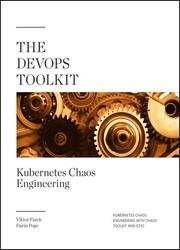 Название: The DevOps Toolkit: Kubernetes Chaos Engineering With Chaos Toolkit And Istio
Название: The DevOps Toolkit: Kubernetes Chaos Engineering With Chaos Toolkit And IstioАвтор: Viktor Farcic, Darin Pope
Издательство: Leanpub
Год: 2020
Страниц: 196
Язык: английский
Формат: pdf (true), mobi, epub
Размер: 11.9 MB
There are very few things as satisfying as destruction, especially when we're frustrated.
What is chaos engineering? What are the principles behind it? We can describe chaos engineering as a discipline of experimenting on a system to build confidence in the system’s capability to withstand turbulent conditions in production. Now, if that was too confusing and you prefer a more straightforward definition of what chaos engineering is, I can describe it by saying that you should be prepared because bad things will happen. It is inevitable. Bad things will happen, often when we don’t expect them. Instead of being reactive and waiting for unexpected outages and delays, we are going to employ chaos engineering and try to simulate adverse effects that might occur in our system.
Through those simulations, we’re going to learn what the outcomes of those experiments are and how we can improve our system by building confidence by making it resilient and by trying to design it in a way that it is capable of withstanding unfavorable conditions happening in production.
How often did it happen that you have an issue that you cannot solve and that you just want to scream or destroy things? Did you ever have a problem in production that is negatively affecting a lot of users? Were you under a lot of pressure to solve it, but you could not "crack" it as fast as you should. It must have happened, at least once, that you wanted to take a hammer and destroy servers in your datacenter. If something like that never happened to you, then you were probably never in a position under a lot of pressure. In my case, there were countless times when I wanted to destroy things. But I didn't, for quite a few reasons. Destruction rarely solves problems, and it usually leads to negative consequences. I cannot just go and destroy a server and expect that I will not be punished. I cannot hope to be rewarded for such behavior.
What would you say if I tell you that we can be rewarded for destruction and that we can do a lot of good things by destroying stuff? If you don't believe me, you will soon. That's what chaos engineering is about. It is about destroying, obstructing, and delaying things in our servers and in our clusters. And we're doing all that, and many other things, for a very positive outcome.
Chaos engineering tries to find the limits of our system. It helps us deduce what are the consequences when bad things happen. We are trying to simulate the adverse effects in a controlled way. We are trying to do that as a way to improve our systems to make them more resilient and capable of recuperating and resisting harmful and unpredictable events.
That's our mission. We will try to find ways how we can improve our systems based on the knowledge that we will obtain through the chaos.
Скачать The DevOps Toolkit: Kubernetes Chaos Engineering With Chaos Toolkit And Istio